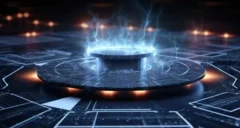
Researchers at the University of Manchester have made a major advance in superconductivity, successfully maintaining reliable superconductivity under strong magnetic fields in a new one-dimensional (1D) system. This breakthrough offers a promising route to achieving superconductivity in the quantum Hall regime, a long-standing challenge in condensed matter physics.
Superconductivity, the ability of certain materials to conduct electricity with zero resistance, holds great potential for the development of quantum technologies. However, achieving superconductivity in the quantum Hall regime, characterized by quantized electrical conductivity, turned out to be a serious challenge.
Study details and initial results
A study published in Nature, details the extensive work of a Manchester team led by Professor Andre Geim, Dr Julien Barriere and Dr Na Hsin to achieve superconductivity in the quantum Hall regime. Their initial efforts followed the usual path where the counterpropagating edge states were placed in close proximity to each other. However, this approach proved to be limited.
"Our initial experiments were primarily motivated by a strong ongoing interest in near-superconductivity induced along quantum Hall edge states," explains Dr. Barrier, lead author of the paper. "This possibility has led to numerous theoretical predictions for the emergence of new particles known as non-Abelian anions."
The team then explored a new strategy inspired by their previous work, which demonstrated that the boundaries between domains in graphene can be highly conductive. By placing such domain walls between two superconductors, they achieved the desired finite proximity between opposing edge states, minimizing the effects of disorder.
"We were encouraged to observe large overcurrents at relatively 'soft' temperatures down to one Kelvin in every device we made," recalls Dr. Barrier.
Discovery of single-mode 1D superconductivity
Further studies showed that proximity superconductivity does not originate from quantum Hall edge states propagating along the domain walls, but rather from purely one-dimensional electronic states existing within the domain walls themselves. These one-dimensional states, the existence of which was proved by the theoretical group of Professor Volodymyr Falko of the National Graphene Institute, showed a greater ability to hybridize with superconductivity compared to quantum Hall edge states. The inherent one-dimensional nature of the internal states is believed to be responsible for the observed reliable overcurrents at strong magnetic fields.
This discovery of single-mode one-dimensional superconductivity demonstrates exciting opportunities for further research. "In our devices, electrons propagate in two opposite directions in the same nanoscale space without scattering," explains Dr. Barrier. "Such 1D systems are extremely rare and hold promise for solving a wide range of problems in fundamental physics."
The team had already demonstrated the ability to manipulate these electronic states with a gate voltage and observe electron standing waves that modulated the superconducting properties.
“It's exciting to think what this new system can bring us in the future. One-dimensional superconductivity represents an alternative route to the realization of topological quasiparticles that combines the quantum Hall effect and superconductivity,” concludes Dr. Sin. This is just one example of the enormous potential of our findings."
Twenty years after the discovery of the first two-dimensional material graphene, this research from the University of Manchester marks another step forward in the field of superconductivity. The development of this new 20D superconductor is expected to open the door to advances in quantum technology and pave the way for further research into new physics, attracting interest from various scientific communities.


 250
250












